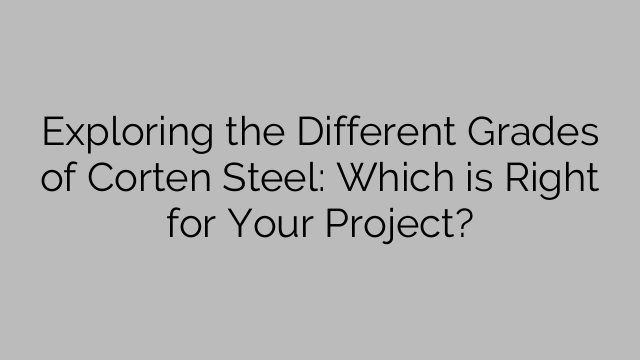Corten steel is primarily composed of iron, copper, chromium, and nickel, which provide the material with its corrosion-resistant properties. The addition of these elements allows the steel to form a protective layer when exposed to the atmosphere. This layer acts as a shield, preventing further corrosion and degradation of the steel beneath it.
There are several grades of Corten steel, classified based on their chemical composition and mechanical properties. The two most common grades are Corten A and Corten B.
Corten A is the most widely used grade, often referred to as “ordinary” Corten steel. It contains a higher concentration of copper and chromium compared to other grades, which enhances its resistance to atmospheric corrosion. Corten A is often used in outdoor sculptures, architectural cladding, and landscaping projects.
On the other hand, Corten B is specifically designed for more demanding applications that require higher strength and improved toughness. It contains a higher concentration of phosphorus and, as a result, has better mechanical properties than Corten A. Corten B is commonly used in structural and architectural applications, such as bridges, buildings, and railway wagons.
Apart from these two main grades, other variations of Corten steel exist to suit different project requirements. For example, Corten Steel IRSM 41-97 is a specialized grade that offers additional resistance to atmospheric corrosion in industrial environments. It is commonly used in applications such as shipping containers and chimneys.
When selecting the right grade of Corten steel for your project, it is important to consider various factors. Firstly, think about the environmental conditions your steel will be exposed to. If it will primarily face mild weathering, Corten A may be suitable. However, if your project will be subjected to harsher conditions, such as coastal areas or heavily polluted industrial areas, Corten B or a specialized grade may be more appropriate.
Additionally, consider the structural requirements of your project. If the steel will be supporting heavy loads or need to withstand impact, a higher grade like Corten B may be necessary to ensure structural integrity.
It is also important to note that Corten steel requires time to develop its trademark patina. The process can take several months to years, depending on the exposure to moisture and air. Therefore, if you desire the distinctive appearance of weathered Corten steel, factor in this time frame when planning your project.
In conclusion, Corten steel offers a unique combination of aesthetics and durability, making it an attractive choice for both indoor and outdoor projects. When choosing the right grade, consider the level of atmospheric corrosion resistance required, the project’s structural needs, and the desired timeframe for the development of the rusted patina. By selecting the appropriate grade of Corten steel, you can ensure your project not only looks stunning but also maintains its strength and longevity for years to come.
[annuncio_2]

